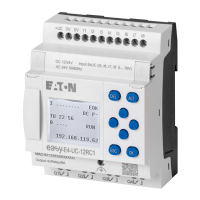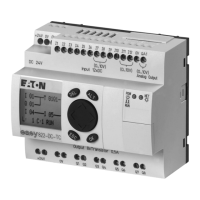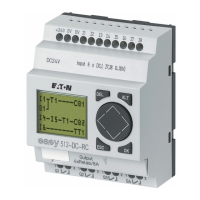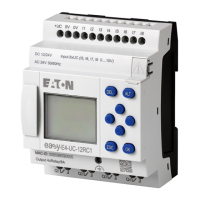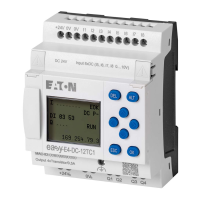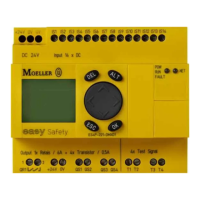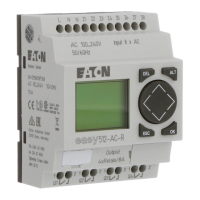
Do you have a question about the Eaton easy500, easy700 and is the answer not in the manual?
| Model | easy500, easy700 |
|---|---|
| Display | LCD |
| Mounting Type | DIN Rail |
| Supply Voltage | 100-240 V AC |
| Digital Inputs | Up to 12 (depending on model) |
| Relay Outputs | Up to 8 (depending on model) |
| Transistor Outputs | Up to 4 (depending on model) |
| Programming | EASY-SOFT programming software |
| Communication | RS-485 |
| Switching Current | 8A (resistive load) |
Details changes and amendments made to the manual since previous editions.
Explains abbreviated designations used for different device models.
Explains the meaning of symbols and conventions used in the manual.
Identifies the intended audience for installing and connecting the easy control relay.
Defines the correct application and installation guidelines for the easy control relay.
Provides an overview of easy basic units and expansion devices with figure.
Presents an overview of easy basic units with a diagram of components.
Details the operation of the easy device, focusing on keypad functions and menu navigation.
Provides instructions for mounting the easy device on DIN top-hat rails or using fixing brackets.
Explains how to connect easy expansion units using the easy-Link bus connector plug.
Specifies tools and cable cross-sections required for electrical connections.
Details power supply connection requirements, including cable protection for AC and DC units.
Explains how easy inputs switch electronically and how to connect contacts like pushbuttons and switches.
Explains how Q outputs operate as isolated contacts and lists associated relay coils controlled by circuit diagram outputs.
Explains behavior with inductive loads and short-circuit/overload on transistor outputs, including monitoring and reset functions.
Explains connecting bus modules and gateways to easy700 devices for communication via various networks like AS-Interface and CANopen.
Provides checks for power supply and input connections before switching on easy, with safety precautions for unexpected motor startups.
Guides users on how to select the menu language on first startup or from the System menu.
Explains the two operating modes, RUN and STOP, and their behavior during power failures and circuit diagram entry.
Introduces creating a first circuit diagram using a simple lamp control example with relays, covering wiring and component connection.
Explains the basic operation of easy, including keypad buttons for editing circuit diagrams and function relays.
Covers working with contacts and relays in easy circuit diagrams, including input/output contacts and relay coils.
Introduces function relays that simulate conventional control devices and lists available types in easy with their designations.
Introduces analog value comparators and threshold value switches, detailing their integration into circuit diagrams and parameter settings.
Introduces up/down counters and frequency counters, detailing their integration into circuits and operating modes.
Introduces high-speed and frequency counters, explaining their applications and counter frequency/pulse shape.
Introduces text displays for easy500/700, explaining text triggering and compatibility with easy600.
Introduces weekly timers for easy500/700 devices with real-time clocks, detailing their integration and function.
Introduces operating hours counters for recording system operating hours and setting maintenance intervals.
Introduces timing relays for controlling switch times and delay times, detailing their integration and parameter settings.
Explains the use of jumps to optimize circuit diagram structure and implement selector switch functions.
Introduces year time switches for easy500/700 devices, explaining their integration and function for special on/off switching.
Introduces the master reset function relay for setting markers and outputs to '0' with one command.
Covers basic circuits in easy, explaining negation (contact and coil), permanent contact, and series circuits.
Introduces circuit examples, starting with star-delta starting circuits using conventional contactors and easy.
Explains how to protect the easy device with a password against unauthorized access, covering entries and areas protected.
Provides instructions on how to change the easy device's menu language via the System menu.
Explains how to alter function relay parameters like timing relay setpoints and counter setpoints directly from the PARAMETER menu.
Covers setting the device's date and time, including how to set the clock and enter values for hour, minute, day, month, and year.
Explains input signal evaluation with delay to prevent issues from contact bounce and how to switch debounce off.
Explains that cursor buttons (P buttons) need activation via the System menu to function as inputs.
Highlights the importance of startup behavior during commissioning and how to set it for easy devices.
Details how to set the cycle time in STOP mode via the SYSTEM menu, specifying the value range and useful applications.
Explains the possibility of retentively storing actual values of markers, timing relays, and counters.
Explains how to display device information like hardware/OS versions, program name, and terminal mode via the INFO menu.
Describes the internal processing of the easy circuit diagram, including segments and evaluation steps.
Details setting delay times for inputs and outputs to ensure clean switching signals, covering debounce behavior.
Explains how easy monitors its functionality using system tests and timeout watchdogs for response times.
Details monitoring for short-circuits or overloads on outputs using internal inputs and error outputs.
Explains how to expand easy700 with local modules or remote expansion using coupling units and lists compatible bus modules.
Explains how to transfer circuit diagrams via serial interface to memory cards or PCs using easySoft software.
Introduces the EASY-M32K memory card for easy500/700 and explains compatibility with older memory card types.
Introduces easySoft-Basic and easySoft-Pro PC programs for creating, testing, and managing circuit diagrams.
Explains operating easy500/700 with remote displays and operator units, detailing advantages and compatible units.
Explains how to find and interpret the device version number for service and EASY-SOFT-BASIC selection.
Lists easy system messages on the LCD, their explanations, and recommended remedies for troubleshooting.
Provides a troubleshooting guide for common issues during circuit diagram creation, including explanations and remedies.
Lists potential events and issues encountered with easy devices, such as data retention, menu display, and startup problems.
Lists approvals and national approvals for easy500/700 devices and shipping approvals for expansion units.
Provides approvals and national approvals for expansion devices and shipping approvals for easy6.. units.
Covers technical data including standards, general specifications, and climatic/ambient conditions for easy devices.
Lists usable contacts for function relays, detailing their N/O, N/C representations and corresponding pages.
Provides definitions for key terms related to easy devices, including analog input, output, operating modes, and function relays.
Defines terms like Impulse relays, Connect mode, Local expansion, and explains the function of P Buttons and retention.



